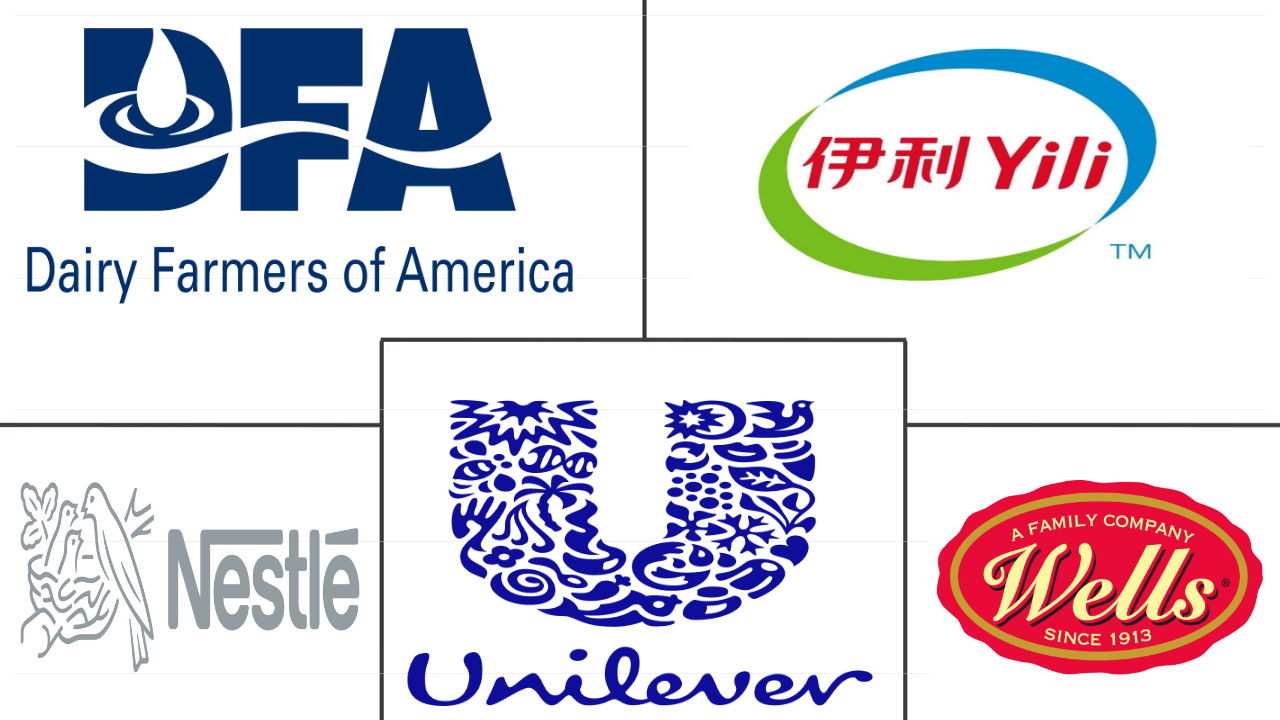Market Size of ice cream Industry
| Icons | Lable | Value |
|---|---|---|
|
|
Study Period | 2017 - 2029 |
|
|
Market Size (2024) | USD 109.5 Billion |
|
|
Market Size (2029) | USD 131.5 Billion |
|
|
Largest Share by Distribution Channel | Off-Trade |
|
|
CAGR (2024 - 2029) | 3.72 % |
|
|
Largest Share by Region | Europe |
|
|
Market Concentration | Low |
Major Players |
||

|
||
|
*Disclaimer: Major Players sorted in no particular order |
Ice Cream Market Analysis
The Ice Cream Market size is estimated at 109.5 billion USD in 2024, and is expected to reach 131.5 billion USD by 2029, growing at a CAGR of 3.72% during the forecast period (2024-2029).
109.5 Billion
Market Size in 2024 (USD)
131.5 Billion
Market Size in 2029 (USD)
2.68 %
CAGR (2017-2023)
3.72 %
CAGR (2024-2029)
Largest Market by Distribution Channel
84.69 %
value share, Off-Trade, 2023
The growth of segment in the country is largely driven with the existence of an inviting place for customers to shop, as they are constantly drawn to make large purchases.
Largest Market by Region
42.32 %
value share, Europe, 2023

Over the review period, indulgence and the increasing consumer preference for ice cream as a leisure product drove the growth and innovative flavors are further driving the segment.
Fastest-growing Market by Distribution Channel
4.30 %
Projected CAGR, Off-Trade, 2024-2029
The onset of the experimential economy and the rising social media platforms with increasing consumer reach in the market is driving the off trade channels through online channels
Fastest-growing Market by Region
5.08 %
Projected CAGR, South America, 2024-2029
Health and wellness trends in South America led to the inclination of consumers toward low-fat, lactose-free variants, and calcium-rich variants, with rising growth for gluten-free, low-sugar ice creams.
Leading Market Player
14.54 %
market share, Unilever PLC, 2022

Unilever Group gained a competitive edge over other players due to its extensive product portfolio with wider brand presence, along with its strategic moves toward innovation.
Strong penetration of organized retail channels propelling the market growth.
- The off-trade segment dominates the distribution channels of the global ice cream market. In the off-trade segment, consumers prefer buying ice cream majorly from supermarkets and hypermarkets, as people get discount coupons for bulk shopping in supermarkets. As a result, the off-trade channel is considered the primary distribution channel for the sales of ice cream, with more than 74% of overall sales as of 2023 globally.
- Convenience stores are the second-largest channel for the sales of ice cream after supermarkets and hypermarkets. In 2022, the sales value of ice cream through convenience stores increased by 3.4% compared to 2021. Many convenience stores stay open longer than traditional retail stores, resulting in more time in the day for the companies' products to be sold.
- Ice creams are commonly consumed as after-meal snacks in restaurants and foodservice channels, which is further boosting the global ice cream market growth. As of 2022, 47% of consumers consumed meals and ice cream at restaurants, and 31% of consumers ordered their food from foodservice channels globally.
- Africa had the highest sales of ice cream through on-trade channels globally, accounting for a major share of 50% in 2023. The sales are driven by the strong preference for eating out in the region. South Africa and Egypt are the leading countries in terms of sales of ice cream through on-trade channels in Africa. In 2022, the two countries covered 79% of sales in terms of volume in the total ice cream sales through on-trade channels in the region. In 2022, there were 3.5 million reservations in South Africa, seating 17.8 million diners at restaurants across the country. In 2020, despite the pandemic, around 68% of African people showed a willingness to eat out.
Consumer growing preference towards sweet indulgence driving the market growth.
- The global ice cream industry observed growth of 2.83% in 2022 compared to 2021. The growth was attributed to the rising number of consumers with a sweet tooth globally. In 2022, it was observed that the average Kiwi (People of New Zealand) consumed 28.4 l of ice cream. The United States, Australia, and Finland had a per capita consumption of volume of 20.8 l, 18.0 l, and 14.2 l in 2022, respectively.
- In North America, premium and regular ice cream hold 80% of the market. In 2022, 16% of the total population of North America preferred chocolate-flavored ice cream, followed by cookie N cream and vanilla, preferred by 13% and 12% of the population, respectively. Some flavors, such as cookie dough and mint chocolate dip, were preferred by 11% of the population. In 2022, 37% of consumers preferred eating ice cream out of a bowl.
- In the Middle East, consumers prioritize products' shelf life to store them conveniently. Ice creams have a longer shelf life, ranging from 12 to 24 months, depending on the temperature. Consumers in the Middle East prefer to consume ice cream at home.
- During the review period (2017-2022), in Asia-Pacific, China dominated the ice cream industry with a production of a whopping 4.3 billion l worth of ice cream. India, Vietnam, and Indonesia amassed a total of 13 billion l worth of ice cream sales. India sold 657 million l of ice cream in 2021. With the increased innovation in the ice cream industry, the demand for such products is expected to grow during the forecast period (2025-2029).
Ice Cream Industry Segmentation
Off-Trade, On-Trade are covered as segments by Distribution Channel. Africa, Asia-Pacific, Europe, Middle East, North America, South America are covered as segments by Region.
- The off-trade segment dominates the distribution channels of the global ice cream market. In the off-trade segment, consumers prefer buying ice cream majorly from supermarkets and hypermarkets, as people get discount coupons for bulk shopping in supermarkets. As a result, the off-trade channel is considered the primary distribution channel for the sales of ice cream, with more than 74% of overall sales as of 2023 globally.
- Convenience stores are the second-largest channel for the sales of ice cream after supermarkets and hypermarkets. In 2022, the sales value of ice cream through convenience stores increased by 3.4% compared to 2021. Many convenience stores stay open longer than traditional retail stores, resulting in more time in the day for the companies' products to be sold.
- Ice creams are commonly consumed as after-meal snacks in restaurants and foodservice channels, which is further boosting the global ice cream market growth. As of 2022, 47% of consumers consumed meals and ice cream at restaurants, and 31% of consumers ordered their food from foodservice channels globally.
- Africa had the highest sales of ice cream through on-trade channels globally, accounting for a major share of 50% in 2023. The sales are driven by the strong preference for eating out in the region. South Africa and Egypt are the leading countries in terms of sales of ice cream through on-trade channels in Africa. In 2022, the two countries covered 79% of sales in terms of volume in the total ice cream sales through on-trade channels in the region. In 2022, there were 3.5 million reservations in South Africa, seating 17.8 million diners at restaurants across the country. In 2020, despite the pandemic, around 68% of African people showed a willingness to eat out.
| Distribution Channel | |||||||
| |||||||
| On-Trade |
| Region | |||||||||||||
| |||||||||||||
| |||||||||||||
| |||||||||||||
| |||||||||||||
| |||||||||||||
|
Ice Cream Market Size Summary
The ice cream market is experiencing steady growth, driven by increasing consumer demand for this popular dairy dessert. The market is characterized by a significant preference for off-trade distribution channels, particularly supermarkets and hypermarkets, which dominate global sales due to their bulk purchasing discounts. Convenience stores also play a crucial role, benefiting from extended operating hours that allow for increased sales opportunities. The on-trade segment, especially in regions like Africa, is bolstered by a strong culture of dining out, with countries such as South Africa and Egypt leading in on-trade ice cream consumption. The market's expansion is further supported by the rising number of ice cream parlors and scoop shops, which cater to diverse consumer tastes and preferences.
Regionally, the ice cream market shows varied trends. In North America, premium and regular ice creams are highly favored, with chocolate, cookie N cream, and vanilla being the top flavors. Meanwhile, in the Middle East, consumers prioritize products with longer shelf lives, often consuming ice cream at home. The Asia-Pacific region, particularly China and India, is witnessing significant growth, driven by increased consumer spending and a willingness to try new flavors. Developed markets in Europe and North America are seeing a shift towards healthier options, with consumers seeking GMO-free, preservative-free, and low-calorie products. The market remains fragmented, with major players like Dairy Farmers of America Inc., Inner Mongolia Yili Industrial Group Co. Ltd, Nestlé SA, Unilever PLC, and Wells Enterprises Inc. leading the industry.
Ice Cream Market Size - Table of Contents
-
1. MARKET SEGMENTATION (includes market size in Value in USD and Volume, Forecasts up to 2029 and analysis of growth prospects)
-
1.1 Distribution Channel
-
1.1.1 Off-Trade
-
1.1.1.1 Convenience Stores
-
1.1.1.2 Online Retail
-
1.1.1.3 Specialist Retailers
-
1.1.1.4 Supermarkets and Hypermarkets
-
1.1.1.5 Others (Warehouse clubs, gas stations, etc.)
-
-
1.1.2 On-Trade
-
-
1.2 Region
-
1.2.1 Africa
-
1.2.1.1 By Distribution Channel
-
1.2.1.2 Egypt
-
1.2.1.3 Nigeria
-
1.2.1.4 South Africa
-
1.2.1.5 Rest of Africa
-
-
1.2.2 Asia-Pacific
-
1.2.2.1 By Distribution Channel
-
1.2.2.2 Australia
-
1.2.2.3 China
-
1.2.2.4 India
-
1.2.2.5 Indonesia
-
1.2.2.6 Japan
-
1.2.2.7 Malaysia
-
1.2.2.8 New Zealand
-
1.2.2.9 Pakistan
-
1.2.2.10 South Korea
-
1.2.2.11 Rest of Asia Pacific
-
-
1.2.3 Europe
-
1.2.3.1 By Distribution Channel
-
1.2.3.2 Belgium
-
1.2.3.3 France
-
1.2.3.4 Germany
-
1.2.3.5 Italy
-
1.2.3.6 Netherlands
-
1.2.3.7 Russia
-
1.2.3.8 Spain
-
1.2.3.9 Turkey
-
1.2.3.10 United Kingdom
-
1.2.3.11 Rest of Europe
-
-
1.2.4 Middle East
-
1.2.4.1 By Distribution Channel
-
1.2.4.2 Bahrain
-
1.2.4.3 Iran
-
1.2.4.4 Kuwait
-
1.2.4.5 Oman
-
1.2.4.6 Qatar
-
1.2.4.7 Saudi Arabia
-
1.2.4.8 United Arab Emirates
-
1.2.4.9 Rest of Middle East
-
-
1.2.5 North America
-
1.2.5.1 By Distribution Channel
-
1.2.5.2 Canada
-
1.2.5.3 Mexico
-
1.2.5.4 United States
-
1.2.5.5 Rest of North America
-
-
1.2.6 South America
-
1.2.6.1 By Distribution Channel
-
1.2.6.2 Argentina
-
1.2.6.3 Brazil
-
1.2.6.4 Rest of South America
-
-
-
Ice Cream Market Size FAQs
How big is the Global Ice Cream Market?
The Global Ice Cream Market size is expected to reach USD 109.54 billion in 2024 and grow at a CAGR of 3.72% to reach USD 131.50 billion by 2029.
What is the current Global Ice Cream Market size?
In 2024, the Global Ice Cream Market size is expected to reach USD 109.54 billion.

